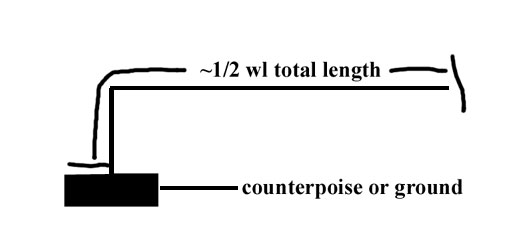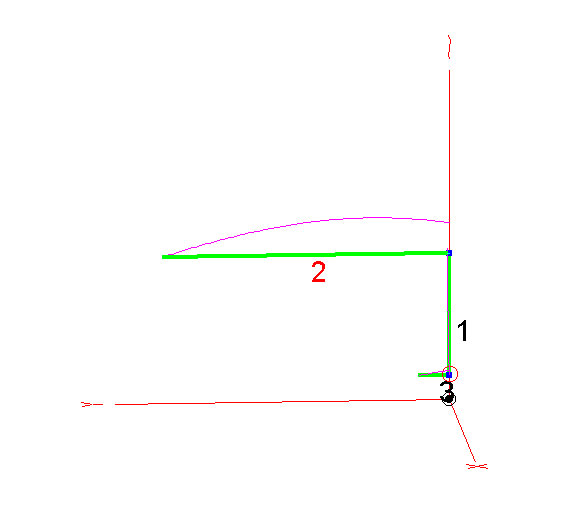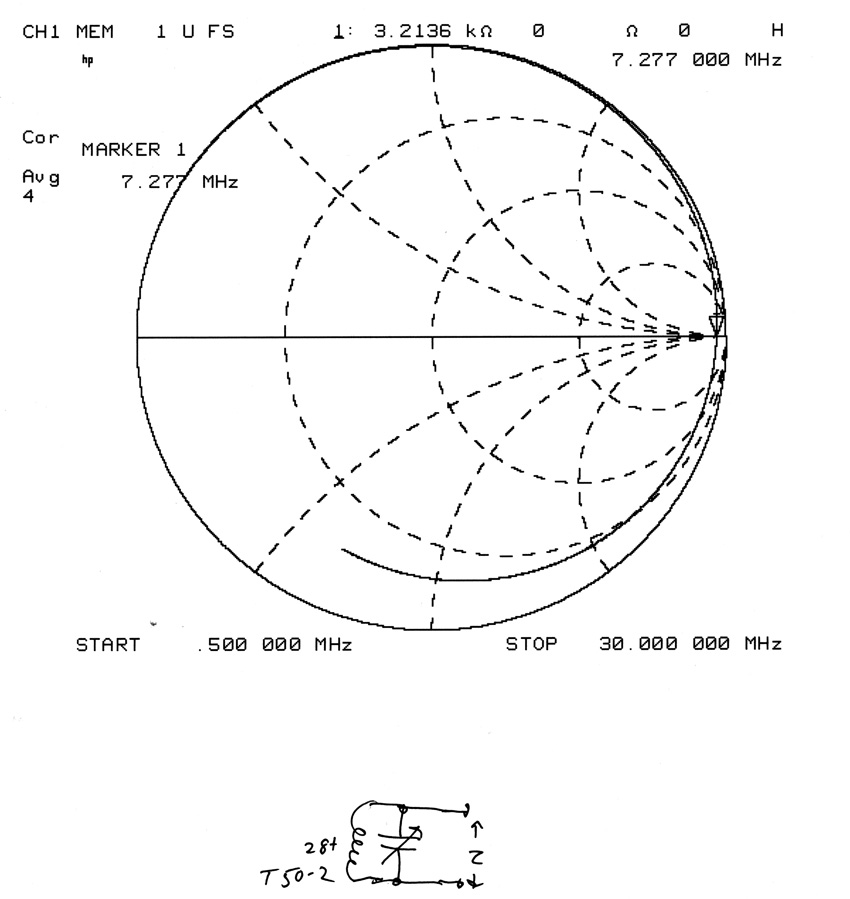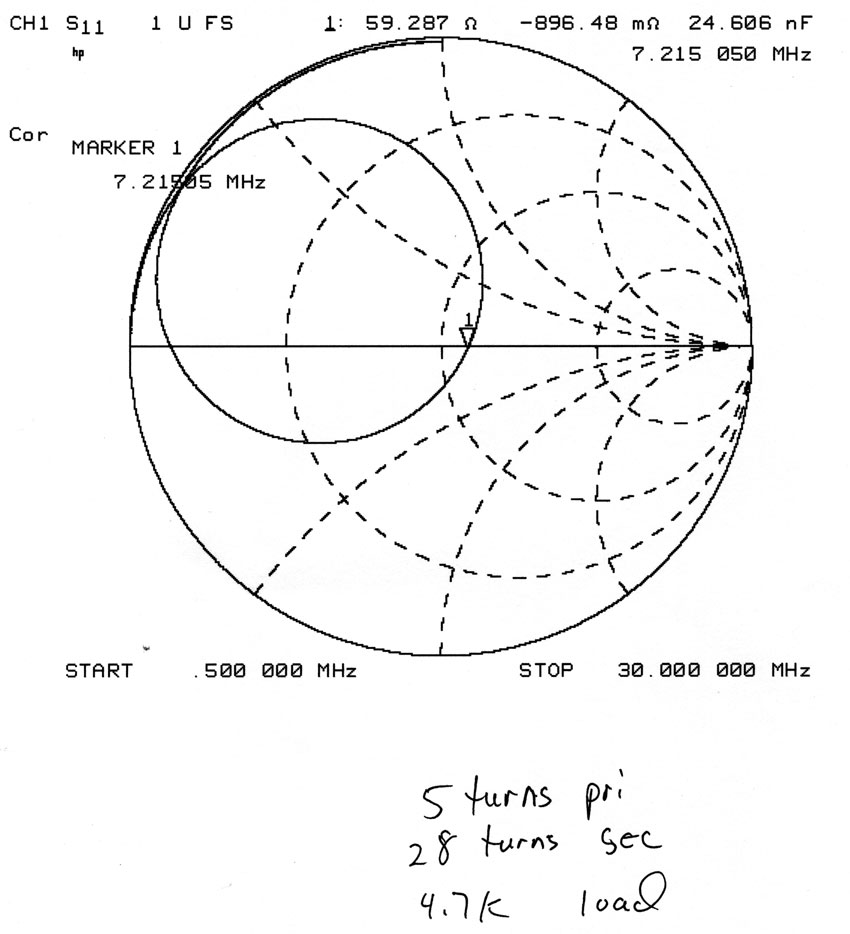End Fed Half Wave Antennas
End-fed halfwaves have become increasingly popular. They also have become bathed in misinformation, mystique, and contradiction.
Some people swear by endfed halfwaves, while others swear at them. The reason for that is simple, end-fed half waves have problems that affect consistency of user results.
The purpose of this article is to show why opinions vary widely by including analysis's of typical antennas and measurements of components. The analysis of a particular style of end fed antenna should include best and worse case scenarios using real-world component values. It is imperative for any analysis to include data of common mode currents on feed lines and how changes might affect performance.
Styles or Types of EFHW Antennas
There are four basic styles or types of end fed HW antennas:
- Coaxial feed with a choke
- Coaxial feed with a skirt
- Stub feed
- Direct feed using a lumped matching network or tuner
The four styles above share one common trait. Absent a counterpoise of some type and proper care in construction, they all induce common mode currents on the feed system. The order of feed problem severity may surprise many of us. The list above is actually ranked in order of construction care required or construction difficulty!
The two configurations thought of as "dipoles" are actually the worse of the systems. We'll see why as we analyze each type. I'll start below with the simplest system.
Direct end feed or traditional longwire style with matching network
The direct end feed antenna brings the end of the halfwave to a transformer or lumped component network of some type. The network is connected to something it "pushes" against so current can be forced into the antenna. The system looks like this:

We can calculate end-impedance of an antenna in the clear with EZnec. The model is:

The model for this antenna consists of the following wires:

The feedpoint impedance (the little circle on the antenna view) is:
EZNEC+ ver. 4.0
6/2/05 6:37:43 PM
---------------
SOURCE DATA
---------------
Frequency = 7.08 MHz
Source 1 Voltage =
574.6 V. at -1.15
deg.
Current = .1741 A.
at 0.0 deg.
Impedance = 3300 - J
66.09 ohms
Power = 100 watts
SWR (50 ohm system)
= 66.023 (75 ohm
system) = 44.015
The current distribution of the antenna is:
CURRENT DATA
---------------Frequency
= 7.08 MHz mean
value of current in
segment
Wire No. 1 antenna:
50 segments, .4 ft
per segment
(junction of wire 3,
counterpoise wire)
.17408a
4 ft
up
.34742a
8 ft
up
.56407a
12 ft
up
.76347a
16 ft
up
.93698a
20 ft
up
1.0795a
Wire No. 2: 46.5 ft
long 24 ft high,
.465 ft per segment
at top end of
vertical wire
1.0929a
4.65
ft
1.2016a
9.3
ft
1.2744a
13
ft
1.2934a CURRENT
MAXIMUM
18.6
ft
1.2542a
23.2
ft
1.1603a
34.8
ft
.70952a
Open
End
.01971a
Wire No. 3
counterpoise 5 ft
long 4 ft high .25
ft per segment
at junction to
antenna wire
.16418a
1
ft
.14095a
2
ft
.10931a
3
ft
.07673a
4
ft
.04285a
5 ft
Open
.00584a
| Note: The very small difference in apparent currents in the counterpoise and antenna at their junction is caused by the counterpoise being short. The short counterpoise has a very rapid reduction in current along its length. Eznec gives the mean current over the length of a segment, not the segment entrance or exit current. This means the high current taper makes the average current along the length of a segment appear to be less. |
One recently proposed theory is this; "if the antenna is not exactly resonant, ground currents will flow." We already know ground currents flow with a resonant end-fed because end-impedance is not infinite. Let's change frequency 10%, since this would be equivalent to a 10% error in length of all sections, and see how much ground currents increase...
EFHW standard
6/3/05 5:43:47 PM
---------------
CURRENT DATA
---------------Frequency
= 7.788 MHz
lowest vertical
antenna
segment .37542
counterpoise first
segment
.35496a
Before at resonance we had:
lowest vertical antenna segment .17408a
counterpoise first segment .16418a
Being 10% off resonance just about doubles current. We see it is a definite current increase, but not one from zero to problematic currents! The proposal exact resonance eliminates all current in a counterpoise isn't correct. A 10% length error only doubles current.
Moving 5% in frequency:
EFHW standard
6/3/05 6:20:14 PM
---------------
CURRENT DATA
---------------Frequency
= 7.434 MHz
lowest vertical
antenna
segment
.2049
counterpoise first
segment
.19385
| Note: The very small difference in apparent currents in the counterpoise and antenna at their junction is caused by the counterpoise being short. The short counterpoise has a very rapid reduction in current along its length. Eznec gives the mean current over the length of a segment, not the segment entrance or exit current. This means the high current taper makes the average current along the length of a segment appear to be less. |
With a 5% length error from resonance, we now see only an 18% increase in current. That's negligible since many other things we might do (like moving the antenna a few feet in height) would make a much larger change.
---------------
SOURCE DATA
---------------Frequency
= 7.434 MHz
Source 1 Voltage =
924.9 V. at -58.15
deg.
Current = 0.2049 A.
at 0.0 deg.
Impedance = 2382 - J
3834 ohms
Power = 100 watts
We can see there is some merit to maintaining resonance because current is at a minimum value, but we only need to worry when resonance errors are somewhat large. When length errors are modest (under 5%) the error has virtually no effect on ground current. The reason for this is very simple. The reactance or lack of resonance isn't what determines current, the resistive part of the impedance does. We are looking for a resistance peak in the end-impedance of the antenna...not necessarily resonance. The source resistive part at resonance was 3300 ohms. At 5% error it was 2382 ohms.
With the non-resonant antenna, we have increased electric fields around the feedpoint. Voltage is 925v instead of 575 volts. RF voltages (the electric field) might be an issue with end-fed antennas.
What else affects Antenna Impedance?
From above we see higher antenna resistance is a good thing for current, and length is not overly critical. We also see lower reactance is a good thing for voltage, and length can affect voltages (and the electric field) surrounding the antenna and counterpoise near the feedpoint.
What about a thicker antenna? With a 1" thick antenna 7 MHz impedance becomes 1684 - J 716.3 ohms and resonance is well below 6 MHz. The reactance problem is because the counterpoise is too short. The drastic resistance reduction at peak resistance occurs because the wire is thicker. Obviously a thicker antenna has higher ground currents!
Half-wave broadcast towers often have impedances under 800 ohms at resonance.
What about antenna surroundings? As the area around the antenna becomes more cluttered and/or has more power loss, antenna end-resistance is reduced! Over perfect ground the antenna end-impedance almost doubles from that over average ground. Over lossy ground, especially when the antenna is low in height, feed resistance decreases even more.
With a small counterpoise and end-feed we:
- need to keep the antenna clear of lossy media including the earth.
- should try to use a reasonably thin antenna element to minimize current.
- stay within a few percent of resonance to minimize feedpoint voltage and current.
- always have the same current flowing into a counterpoise (of some form) as flows into the antenna.
- should use the largest counterpoise that can be reasonably implemented, but avoid small counterpoise systems that have wires significantly longer than 1/4 wl
Improvements
The best solution I can think of to common mode or "RF in the shack" problems with this form of antenna is to isolate the counterpoise or antenna ground from the station feed. At low power levels a simple link coupled matching network is a good solution, provided the secondary has no RF path to station equipment. One way to accomplish this is by using two output terminals that float.

In the circuit above:
- Determine the maximum impedance ratio between input and output.
- The turns ratio is the square root of that ratio
- The reactance value of C1 near 3/4 mesh at the lowest frequency and secondary reactance of T1 should be the maximum expected load impedance over the turns ratio
- C2 is optional, and should be the value of C1 or larger if used. It will allow wide adjustment of matching range
Assume we have a 5000 ohm load and 50 ohm rig. The turns ratio of T1 is sqrt of 5000/50 or a 10:1 ratio.
The reactance of C1 at 3/4 mesh (so you have adjustment range) should be 5000/10, or 500 ohms. (This is a loaded Q of ten, you need LESS Q with lower transformation ratios and more Q with higher ratios or the circuit becomes too sharp or too "mushy" to tune.)
The reactance of L1 secondary should be 500 ohms in this example.
U1 should connect to the antenna, U2 to the counterpoise or ground which should NOT connect to the station equipment. The counterpoise should be as long and straight as possible, and directly under the antenna if possible. Ideally the counterpoise, if less than 8 wires 1/4 wl long, should be elevated and insulated from earth. Do NOT make the counterpoise longer than 1/4 wl, especially if it is only a single wire! Most of us, since this is a temporary or compromise antenna, will use a very small ground system. I've found connecting a counterpoise to earth, say a ground rod, actually reduces antenna efficiency.
If you run low power and don't have a ground or counterpoise, you might just connect U2 right back to the coax shield from the radio. This way you can use the capacitance of the radio and station wiring as a ground system.
To
be continued soon!
Zepp or stub-matched
antenna
Dipole with coax having a choke at the end
Impedance
Feed Systems
Common Mode Currents
Modified June 1, 2005 more data being added over the next few days...
At high power 3 dB loss in even the largest components would mean extreme heat, at low power its difficult to notice several dB loss as any type of component heating. The paradox is while 1500 watt systems could often stand to lose 10 dB or more as heat...low power systems (at least in my way of thinking) should try to squeeze every milliwatt out!
Let's look at a matching system in what I consider one of the most difficult methods of feeding an antenna, the end fed half-wave. If anyone has any other matching systems that are commonly used or recommended, send me one and I'll measure it in my lab and post the data here.
There is also some discussion of common mode current, and the lack of common mode current because we sometimes can't observe ill effects.
I remember working with a new graduate engineer, let's call him Simon, on an antenna system. When I asked Simon if he checked for proper feedpoint isolation, he turned an SWR analyzer on and wrapped his fingers around the feed line. Seeing no change in SWR, he declared the system free of common mode currents! Convincing him to use a clamp-on RF meter, we found the feed line that acted "cold" to the touch actually had significant common mode currents.
Where did Simon go wrong? Pretty simple when we think about what he was actually testing. High voltage points interact with body capacitance at HF, not current points! Had Simon grabbed the coax at a high voltage point of the shield, he might have found interaction with SWR. Unfortunately a significantly high impedance or high voltage point rarely appears along the outside of a "grounded" shield. That's because the cable is often routed near other conductors. The cable is also thick, and that limits surge impedance.
Even if we modify common mode impedance with body capacity, the feedpoint is where multiple paths combine and make the transition to the feed line. Measuring SWR changes is a very poor way to determine proper operation. Even the most basic antenna systems, once the feed line becomes involved, can become a terribly complex web of paths. The myth that we can grab a cable to see if a system needs a balun or has common mode problems is a very BIG myth.
End-fed Matching Circuit Measurement
In order to quantify efficiency of a typical matching system, I made a concerted effort to duplicate the coupler AA5TB describes on his web page. (I think the basic AA5TB system is a good one, but I'd probably make a few changes.)
I used the same wire gauge, core type and material, same turns ratio, and a very similar brand new capacitor of the same construction and style for measurements below. The measurements below are on equipment certified to national standards. The primary instrument is a HP-8753E network analyzer, and was verified by a HP-4191A laboratory standard impedance test set.
Here is an impedance sweep of the parallel tuned network, adjusted to the upper end of 40 meters. AA5TB has it at http://webpages.charter.net/aa5tb/coupler2.html
You can see, despite claims the antenna is ground independent, the secondary is connected to.....ground. Actually I can eliminate that ground connection and, by increasing the transformer turns ratio, still feed the antenna! How is it possible to feed a single terminal with current? Simple. The hanging end of the winding will capacitively couple to ground and provide a path for return currents. We can't get away from it, an end-fed wire is NOT a dipole. The feed line and everything connected to the feed line becomes the return path for displacement currents. It always has, it always will. The common mode feed line and antenna currents, at the matching system, will always be equal. The same common mode current will leave on the shield as pushes up into the antenna, the only exception is if the matching system is physically large compared to the antenna and the matching system by itself becomes a groundplane.
Remember I made a best effort to duplicate the matching system. The measured data follows:

You can see from the data above, with no load on the primary or secondary, this parallel resonant circuit looks like 3.2k ohms (J0 at resonance) at 7 MHz.
3.2k ohms is the equivalent parallel (or shunting) resistance across the load. This resistance is caused by losses in the inductor, the variable capacitor, and some very small wiring resistances. Losses actually break down this way:
Inductor measured Q = 78 @ L = 4.12 uH
Capacitor measured Q = 22.8 @ C=118.7 pF
Reactance was 186.2 ohms
While the inductor had what I consider poor Q, the capacitor was a real killer. It was a brand new capacitor from stock of sample parts. Four more tested similarly, with the highest Q of the five only 38.5! The manufacturer was Apollo
The only other miniature capacitor I had of similar construction to the one AA5TB used was a Taiwanese capacitor with the logo "OM". This batch was another group of sample parts. In this case capacitor Q at 118.7 pF ranged from 38.0 to 43.2. This is still very low Q.
The parallel resistance representing losses was 4.9 k ohms, up from 3.2 k ohms using the OM capacitors.
The final test was an air variable. The air variable was a standard compact receiving type 140 pF capacitor manufactured by Oren Elliot Products (All Star Products) in Edgerton, Ohio. In this case capacitor Q measured 2565!! That Q is roughly 100 times the Apollo capacitor Q. I only measured a sample of one capacitor.
Using this capacitor with no other changes, the parallel resistance of the above circuit was around 20,000 ohms.
Efficiency Table
The table below used 5 watts applied power and a 4700 ohm load.
| Capacitor | Cap RMS Voltage | Power at load | Power lost | % eff | Loss |
| Apollo Series | 98.5 | 2.07 W | 2.93 W | 41.4 % | -3.8 dB |
| OM series | 109.6 | 2.56 W | 2.44 W | 51.2 % | -2.9 dB |
| Air Variable | 132.8 | 3.75 W | 1.25 W | 75 % | -1.2 dB |
Of particular concern is the low Q of compact capacitors as well as upper impedance limits of compact powdered iron cores wound with large numbers of turns. It would be much better to use a small air variable rather than notoriously troublesome "transistor radio" tuning capacitors.
The inductor could also be improved with a taller core or stack of cores. That would minimize the number of turns required for resonance! Also a different mix might increase Q.
On the previous page, I mentioned the impedance ratio of a tightly coupled transformer of high quality was equal to the square of the turns ratio between primary and secondary. If we wanted to match a 4700 ohm load to a 50 ohm source, the turns ratio should be sqrt of 4700/50, or 9.7 : 1.
4700 in parallel with 3300 is 1939 ohms. 1939 ohms over 50 ohms is a resistance ratio of 38.78. The square root of 38.78 is 6.23. 28/6.23 is 4.5 turns. I calculate a 4.5 turn primary based on perfect mutual coupling, the 3.3k secondary loss equivalent parallel resistance, 4700 ohm load, and a 28-turn secondary.
4.5 turns isn't possible, and won't be exact anyway because of flux leakage, lead lengths, and other small imperfections in the system. The plot below is with a 5 turn primary.

Let's work the problem backwards. The 28 turn secondary / 5 turn primary transformer I measured above has a turns ratio of 5.6:1 5.6 squared is 31.36 The measured primary impedance was 62 j0, times the impedance ratio of 31.36, for a net secondary impedance of 31.36*62 = 1944 ohms. That isn't terribly far from the 1939 ohms calculated as 3300 ohms of tank parallel equivalent loss resistance in parallel with 4700 ohms of load resistance!
Measuring things two different ways and comparing results is very useful. It warns us of any errors in measurements, logic, or misapplications of theory.
When I measured the secondary impedance, I calculated I'd need about 4.5 turns on the primary to match a 4700 ohm load in parallel with a loss resistance of 3300 ohms, or 1939 ohms. When I optimized the transformer, I found 5 turns was close enough.
So there we have it. Matching loss in the worse transformer system I measured is around 4 dB. If the antenna was 4700 ohms j0, more power would be consumed in the tank circuit feeding the antenna than is actually applied to the radiating part of the antenna system! Of the power applied to the antenna, a significant portion will be distributed in the antenna feed cables, rig, and everything connected to the rig including the operator and station wiring.
On the other hand we could build a dipole, and feed it with RG-174 cable. We would eliminate about 4 dB of matching circuit losses, and a few dB of power lost in common mode losses. How much RG-174 could we use to equal the end-fed losses? At 50 MHz we could use about 100-feet of RG-174 and break even with end feed using the system I constructed, a small T50-2 toroid with link coupling resonated by a typical polyethylene insulated "broadcast tuning" capacitor. At 7 MHz it's a no-brainer. I'll take the RG-174 dipole feed every time! My reasons are mostly the convenience and repeatability of the feed system.
Another possible alternative is a 1/4 wl 450-ohm Q section or stub. TLA estimates loss as .205dB on 7 MHz with that system.
In my experience it's far easier to have repeatable results with a stub, rather than small inconsistently manufactured lumped networks. Even large tuners using transmitting components become inconsistent in loss measurements at impedance extremes. Losses that would cause big smoke at high power can go unnoticed at low power levels..
End-fed half waves are sometimes inefficient or troublesome feed systems. At low power we might never notice efficiency problems or common mode current problems. Of course at high power very few shortcuts can be tolerated.
as
of 5/27/2005
This page copyright W8JI 2005. All drawings and text may be used when discussing specifics of this article (that's fair use), but may not be used in any other form.